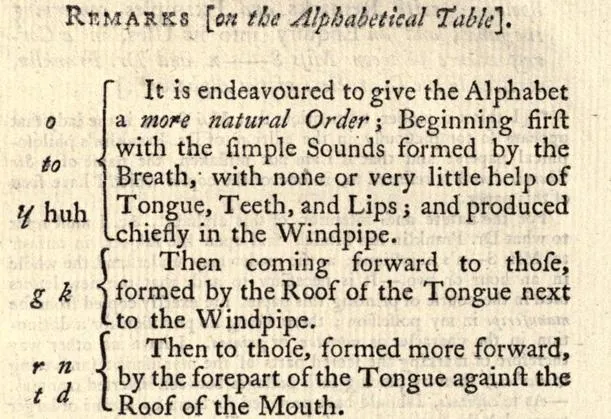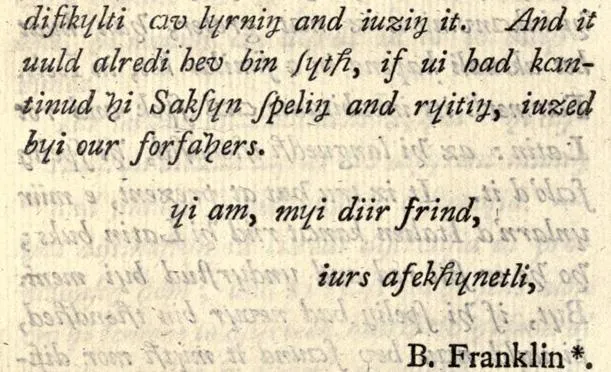Benjamin Franklin’s Phonetic Alphabet
One of the founding father’s more quixotic quests was to create a new alphabet. No Q included
/https://tf-cmsv2-smithsonianmag-media.s3.amazonaws.com/filer/franklin-alphabet1-631.jpg)
Benjamin Franklin was many things. Politician, scientist, inventor, printer author, he was a visionary whose ideas helped shape America. But he also had some notions that, while founded on sound logic and pragmatism, seem quite bizarre in retrospect. For instance, there’s his suggestion that the turkey was a more appropriate national symbol than the eagle, which he saw as “a bird of bad moral character.” Franklin’s vision for American didn’t stop with independence and iconography. He also proposed a redesigned alphabet – a new language for a new nation.
Franklin developed his phonetic alphabet in 1768 but it wasn’t published until 1789, when Noah Webster, intrigued by Franklin’s proposal, included its description in his book Dissertations on the English Language. However, because, Webster lacked the type blocks to illustrate Franklin’s changes, the alphabet wouldn’t be seen until Franklin had new blocks cast to print the alphabet for his 1779 collection of writings, Political, Miscellaneous, and Philosophical Pieces. It was the ultimate test of Franklin’s scholarship and polymathy, a phonetic alphabet designed to have a “more natural Order,” than the existing system. His proposal, “A Reformed Mode of Spelling,” opens with an analysis of spoken English in the form of a table prioritizing the alphabet by sound and vocal effort. Franklin gave preference to “Sounds formed by the Breath, with none or very little help of Tongue, Teeth, and Lips; and produced chiefly in the Windpipe.”

Franklin’s analysis resulted in removing six letters from the alphabet – C, J, Q, W, X, AND Y– that were, in his view, redundant or confusing. The “hard” and “soft” sounds of a C, for example, can easily be replaced by a K and S. Franklin also limited the remaining letters to one sound, “as every letter ought to be,” including vowels. In the phonetic alphabet, “long” vowel pronunciations are achieved using double vowels. The changes weren’t all reductive. Franklin’s alphabet includes six letters of his own devise: a letter that makes a “soft O” sound as in “folly” or “ball”; one that replaces all “sh” sounds as in “ship” or “function”; an “ng” sound; two “th” substitutes; and a letter that replaces both “um” and “un” letter combinations. Franklin first used his new alphabet at length in a 1768 letter to Polly Stevenson, the conclusion of which provides an excellent, and mostly legible example, of his proposed revisions:

Franklin was confident that his new alphabet would easier to learn and, once learned, would drastically reduce bad spelling. He believed any difficulty in implementing a new alphabet would ultimately be overcome by its logic and simplicity. However, biographer Walter Isaacson has written that the alphabet “took his passion for social improvement to radical extremes.” But in the heady days after the Revolution, a national language seemed like a natural development for a new country. Franklin’s proposal found little support, even with those to whom he was closest. He did, however, manage to convert Webster, the pioneer of spelling reform. Webster supported standardizing American spelling but, until meeting Franklin, had advocated against its simplification. After reading Franklin’s “A Reformed Mode of Spelling,” however, Webster was inspired to draft a more conservative proposal for reforming the alphabet, which didn’t depend on creating new characters. The two men supported one another’s pursuits but found little interest from others. Franklin eventually abandoned his plan, while Webster persisted, even publishing books using his new orthography. His efforts were met with resistance and ridiculed by critics as an unsightly corruption of language – critiques that were likely also applied to Franklin’s abandoned scheme.
There can be no doubt that language has influence over a country and its populace. It’s an integral part of one’s national identity. Franklin just took this to the extreme. Perhaps he viewed the alphabet in the same way he saw the turkey, as a something “courageous” and “original” to America. The phonetic alphabet would be an American original too, and a reflection of the men and women living in the new country – pragmatic, efficient, egalitarian.
Sources:
Benjamin Franklin, Political, Miscellaneous, and Philosophical Pieces (1779); Nicola Twiley and Geoff Manaugh, “Six New Letters for a Renovated Alphabet” (St. Bride Foundation, 2005); Jill Lepore, A Is for American: Letters and Other Characters in the Newly United States (2007); Walter Isaacson, Benjamin Franklin: An American Life (2004); “Benjamin Franklin’s Phonetic Alphabet,” Omniglot; Jill Lepore, A Is for American: Letters and Other Characters in the Newly United States (2007)
/https://tf-cmsv2-smithsonianmag-media.s3.amazonaws.com/accounts/headshot/Jimmy-Stamp-240.jpg)
/https://tf-cmsv2-smithsonianmag-media.s3.amazonaws.com/accounts/headshot/Jimmy-Stamp-240.jpg)